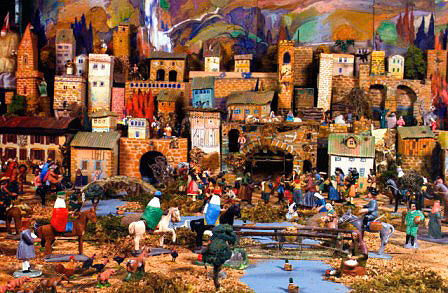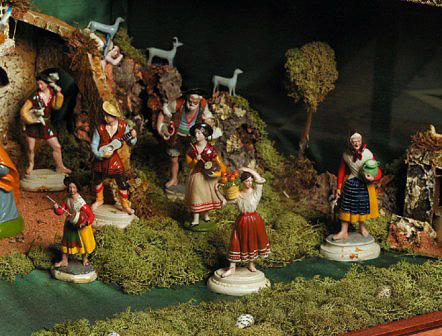15 December
Conferences
CHRISTMAS CYCLE
Talking figures: types, costumes and trades of pre-industrial society in the traditional Hispanic Nativity Scene
D. Ricardo Fernández Gracia
Chair of Navarrese Heritage and Art
If we approach a modern-day nativity scene, we will find delicate three-dimensional representations of the birth of Christ to scale, with architecture in many cases orientalising and figures of a supposedly historicist style. However, until just over a century ago, the traditional nativity scene was based on other assumptions: portal with classical ruins, large rocks and crags and figures dressed according to the customs and traditions of different regions.
The great change with respect to the figures took place at the end of the 19th century and the beginning of the last century, when the Church and the nascent Associations of Nativity Scene Makers - especially the Catalan ones - promoted new formulas. From then on, the old polychrome clay figures, made in the workshops of Murcia or Granada, exponents and synthesis of a centuries-old tradition, began to decline. All this was favoured even more by some directives that, after the Civil War, were addressed from the Spanish Falange to the nativity scene makers and their associations in order to banish the anachronisms of the popular nativity scene.
Behind those innovations there were some causes. Firstly, the Church's custom of not blessing clay images. The new figures of the Olot school were made of wood paste and had a dignified appearance and, above all, a pretended historical fidelity, as their characters were dressed in timeless attire. Precisely because of its propriety and historicity, Olot's aesthetic captivated private clients and institutions with its particular historical vision, derived from the group of the Nazarenes, German painters who reacted against the prevailing Neoclassicism on the basis of the archaeological discoveries in Palestine. In the same vein, the artists of the Parisian street of Saint Sulpice had a decisive influence in Catalonia on the Olot school with a correct, somewhat sweet style influenced by the Nazarene school. With these budgets, parishes, convents and schools, as well as amateurs, opted for these figures, standardising everything related to the nativity scene, always from an orientalist perspective. For the time being, the figures from the Olot workshops coexisted with the traditional terracotta ones, but they would eventually prevail over the latter, which also underwent their own evolution to adapt to fashion with tunics, cloaks and turbans, which would eventually incorporate glued fabrics.
In contrast to the panorama of the last hundred years, dominated by historicism, ancient nativity scenes had a much more symbolic character in all their elements, since in an illiterate society it was easier to catechise through simple messages than to speculate on the reality of 1st century Judea. It was not so much a matter of conjecture, or of organising perspectives and scales, but of conveying messages about the ineffable, by means of ideas.

Traditional nativity scene in Itzea, the Baroja family home in Bera
La cueva y sus personajes
Si en la cueva se colocaban unas ruinas clásicas era para significar que con la venida de Cristo se superaba el Antiguo Testamento. Si se insistía en la colocación de peñas y rocas era para insistir en que el nacimiento del Salvador había tenido lugar entre bestias, en una cueva, fuera del lugar habitado, tras ser rechazada la Sagrada Familia por las gentes. Todo ello daba lugar a reflexionar sobre cómo se podía expulsar a Jesús de los corazones de los hombres. Junto al portal se colocaban velas y faroles y el suelo se sembraba con cristales triturados y conchas para que reflejasen la luz, ya que los belenes estaban concebidos para admirarse por la noche, para acercarse con los sentidos y el espíritu a contemplar la “luz del mundo”.
Las figuras de José y María vestían de unos colores precisos y simbólicos. Ella de rojo o rosa en su túnica, para indicar el color de la carne por la Encarnación, y el azul en el manto que la identificaba como reina del cielo. Frecuentemente la túnica era blanca, para evidenciar su pureza. José, por su parte, combinaba el morado del sufrimiento y sacrificio y el marrón, color con el que se identificaba a los carpinteros. A veces luce manto amarillo, por su pertenencia al pueblo judío. De ordinario y siguiendo las recomendaciones de las visiones de santa Brígida, ambos estaban ante el Niño “hincados de rodillas, lo adoraban con inmensa alegría y gozo”.
El Divino Infante era de grandes proporciones, en sintonía con las viejas normas de tamaño jerárquico, y solía estar en una cuna de contenido trinitario, pues se adornaba con un triángulo y la Paloma del Espíritu Santo, junto a una gloria de cabezas de ángeles. Respecto a los animales, la mula se identifica con el pueblo judío, de ahí que aparezca en algunos casos arrodillada ante el misterio, dando paso a la Nueva Ley, mientras que el buey se asimila con los paganos y la gentilidad.
El agua del río o de la fuente también poseía un contenido simbólico, puesto que donde no hay agua no hay vida. El nacimiento de Jesús se convertía en verdadera fuente de vida.
Ángeles y arcángeles
Las figuras aladas de estos seres celestiales otorgaban al belén su dimensión más ultraterrena. En unos casos eran adoradores u oferentes y en otros portaban instrumentos de la pasión. No hay que olvidar al respecto, la unión de todo lo relativo al belén y a la pasión, pues todo formaba parte del mismo relato.
En algunos casos, en el mismo portal se daban cita los arcángeles Miguel y Gabriel, como en el belén de Salzillo o en el de las Recoletas de Pamplona. El motivo no es otro que el relato del nacimiento que hace la Madre María Jesús de Ágreda en su Mística Ciudad de Dios, en donde afirma: ““El Sagrado Evangelista San Lucas dice que la Madre Virgen, habiendo parido a su Hijo Primogénito, lo envolvió en paños y le reclinó en un pesebre. Y no declara quien le llevó a sus manos desde su Virginal Vientre, porque esto no pertenece a su intento. Pero fueron ministros de esta acción los dos Príncipes Soberanos San Miguel y San Gabriel que, como asistían en forma humana corpórea al misterio, al punto que el Verbo humanado, penetrándose con su virtud por el Tálamo Virginal, salió a luz, en debida distancia, le recibieron en sus manos, con incomparable reverencia…. Y al punto que los Santos Ángeles presentaron al Niño Dios a su Madre, recíprocamente se miraron Hijo y Madre Santísimos, hiriendo ella el corazón del dulce Niño y quedando juntamente llevada y transformada el él”.
Pastores y oferentes
En el belén tradicional cabían espigadores, huertanos recogiendo naranjas, y un sinnúmero de oficios tradicionales propios de la sociedad preindustrial. Todos ellos conformaban un microcosmos festivo, reflejo de la alegría desbordante que producía la llegada de la Nochebuena. Constituía una auténtica explosión de vida, un microcosmos festivo, en donde los textos evangélicos de san Lucas y san Mateo fueron libremente reelaborados, con una fantasía prodigiosa y un artificio de invenciones entre todos los personajes de la vida cotidiana, únicamente contrapuesto con el fasto y la riqueza de los Reyes Magos.
Particular interés poseen los grupos de danzantes y músicos que por las calles y plazas de la estructura tridimensional del belén alegraban el ambiente hasta límites insospechados, ya que ancianos, jorobados y lisiados se contagian y bailan al son de panderos, zambombas, sonajas e incluso instrumentos de viento y cuerda. La exaltación del gaudium que invadía las casas y las celebraciones litúrgicas de aquellos días se reflejaban en el belén popular, no sólo en danzantes y músicos, sino en gestos de pastores y rústicos, tanto en el mercado y en los trabajos ordinarios, como en alborozadas labradoras montadas en burros con sus correspondientes presentes que van cantando y tañendo zambombas o panderetas, viandantes, oferentes, hombres trabajando sus huertas, o almorzando en mesones los típicos huevos fritos o guisando las migas en enormes sartenes.

Detail of shepherds and offerers in a traditional nativity scene
All these figures are a faithful reflection of a rural, pre-industrial society, as are the tiny cork houses. The traditional costumes are those of the Manchegans, Maragatos or huertanos of that Spain before the railway and all the industrial take-off. The men are dressed in Spanish capes, catites, chambergos, shirts, breeches, abarcas, zamarras and gaiters, and the women in sayas, aprons, over-skirts, scarves and hats. The trades and types represented are varied: farmers, herdsmen, hunters, fishermen, wine merchants, market gardeners, blacksmiths, shopkeepers and craftsmen of all kinds subject, with no lack of the destitute such as widows, cripples and beggars, to signify that the Messiah had come for everyone.
Vitality and spontaneity were guaranteed in that story, which was meant to be lived and not only referred to. In the case of the Hispanic nativity scenes, the nativity was not lost, as in Naples, among an extroverted and even crazy people, but the scene became the centre of the whole story.
It makes little difference whether the event takes place in winter, some wear warm clothes, others go about in a simple waistcoat, harvest or pick the most varied fruits, while old and young dance, delouse their husbands and fathers or devote themselves to the most varied tasks of the house and the agro-pastoral environment. Many of these types can be identified with the engravings of Spanish folk costumes printed by Juan de la Cruz.
The Magi, Herod and the Slaughter of the Innocents
The Magi, usually on horseback, dress like Western monarchs with ermine, rich cloaks, crowns and sceptres. They once symbolised the three known continents, but in the nativity scene period they are often associated with the three ages of man. Their main significance is that they are revealed to us as the great manifestation, the Epiphany. Their gifts are associated with the Child King (gold), the Child God (frankincense) and the human Word (myrrh).
Herod also used to dress like a king. Alongside his soldiers dressed in Roman costume, those who sacrifice the innocents wear turban-like hats with red pointed caps, which link them to the executioners in painting from the end of the Middle Ages average and which appear so often in the scene of the Beheading of the Baptist.
